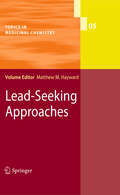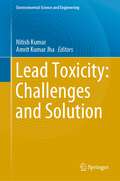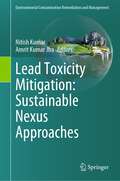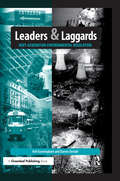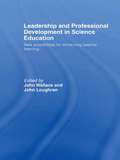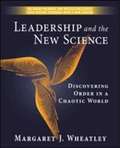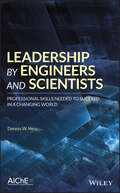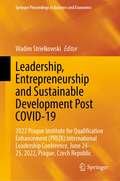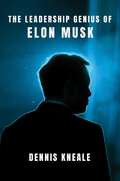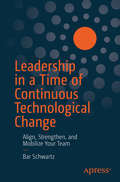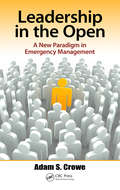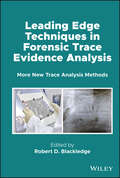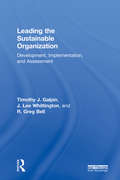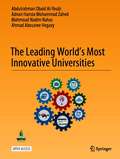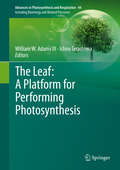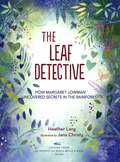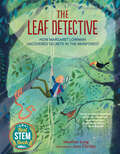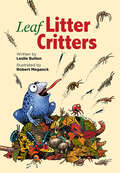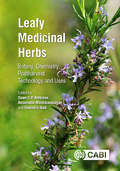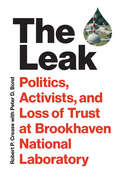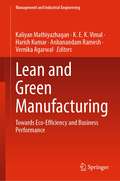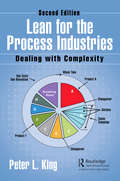- Table View
- List View
Lead-Seeking Approaches
by Matthew M. HaywardChristopher A. Lipinski: Overview of hit to lead: the medicinal chemistâ__s role from HTS retest to lead optimization hand offJeff W. Paslay â_¢ John E. Morin â_¢ Richard K. Harrison: High Throughput Screening in the 21st CenturyJack Andrew Bikker â_¢ Lakshmi S. Narasimhan: Lead Discovery Using Virtual Screening Maurizio Pellecchia: NMR Spectroscopy in Fragment Based Drug DesignKevin D. Freeman-Cook â_¢ Daniel W. Kung: Hit Triage â__ Medicinal Chemistry Strategies to Improve the Odds of Success in DiscoveryJohn W. Ellingboe â_¢ Adam M. Gilbert: Lead Identification
Lead Toxicity: Challenges and Solution (Environmental Science and Engineering)
by Nitish Kumar Amrit Kumar JhaThis book delivers an outline to graduate, undergraduate students, and researchers, as well as academicians who are working on lead toxicity with respect to remediation. It covers sources of lead contamination and its impact on human health and on prospective remediation through multi-disciplinary approaches with application of recent advanced biological technology. Lead is among the elements that have been most extensively used by man over time. This has led to extensive pollution of surface soils on the local scale, mainly associated with mining and smelting of the metal and addition of organic lead compounds to petrol. Release of lead to the atmosphere from various high-temperature processes has led to surface contamination on the regional and even global scale. In addition, plants grown on lead-rich soils incorporate lead, and thus, the concentration of lead in crop plants may be increased. Lead enters in the food chain through consumption of plant material. A high concentration of lead has been found to be harmful to vegetation. As the lead concentration increases, it adversely affects several biological parameters and eventually renders the soil barren. This edited book brings together a diverse group of researchers to address the challenges posed by global mass poisoning caused by lead contamination of soil and plants. The book sheds light on this global environmental issue and proposes solutions to contamination through multi-disciplinary approaches. This book contains three sections. The first section describes the different sources and distribution of lead in soil and plant ecosystems. The second section explains the health risks linked to lead toxicity. The third section addresses sustainable lead toxicity mitigation strategies and the potential applications of recent biological technology in providing solutions. This book is a valuable resource to students, academics, researchers, and environmental professionals doing fieldwork on lead contamination throughout the world.
Lead Toxicity Mitigation: Sustainable Nexus Approaches (Environmental Contamination Remediation and Management)
by Nitish Kumar Amrit Kumar JhaThis edited book brings together a diverse group of researchers to address the challenges posed by global mass poisoning caused by lead contamination of soil and plants. Lead is among the elements that have been most extensively used by man over time. This has led to extensive pollution of surface soils on the local scale, mainly associated with mining and smelting of the metal and addition of organic lead compounds to petrol. Release of lead to the atmosphere from various high-temperature processes has led to surface contamination on the regional and even global scale. Lead is particularly strongly bound to humic matter in organic-rich soil and to iron oxides in mineral soil and is rather immobile in the soil unless present at very high concentrations. In addition, plants grown on lead-rich soils incorporate lead and thus the concentration of lead in crop plants may be increased. Lead enters in the food chain through consumption of plant material. A high concentration of lead has been found to be harmful to vegetation. As the lead concentration increases, it adversely affects several biological parameters and eventually renders the soil barren. The book sheds light on this global environmental issue and proposes solutions to contamination through multi-disciplinary approaches. This book contains three sections. First section describes the different sources and distribution of lead in soil and plant ecosystems. Second section explains the health risks linked to lead toxicity. Third section addresses sustainable lead toxicity mitigation strategies using the potential applications of recent biological technology. This book is a valuable resource to students, academics, researchers, and environmental professionals doing field work on contamination throughout the world.
Leaders and Laggards: Next-Generation Environmental Regulation
by Neil Gunningham Darren SinclairConsensus is growing internationally that traditional command-and-control approaches to environmental regulation have borne much of their low-hanging fruit. Yet it is far from clear what should complement or replace them. Regulatory agencies and policy-makers are struggling with a lack of information about regulatory reform, about what works and what doesn't, and about how best to harness the resources of both government and non-government stakeholders. Progress is being impeded unnecessarily by a lack of shared knowledge of how similar agencies elsewhere are meeting similar challenges and by a lack of data on the success or otherwise of existing initiatives. Despite recent and valuable attempts to deal with such problems in the European Union and North America, these remain islands of wisdom in a sea of ignorance. For example, when it comes to dealing with small and medium-sized enterprises, very little is known, and what is known is not effectively distilled and disseminated. Much the same could be said about the roles of third parties, commercial and non-commercial, as surrogate regulators, and more broadly of many current initiatives to reconfigure the regulatory state. Based on the authors' work for the OECD, Victorian Environmental Protection Authority and the Western Australian Department of Environment Protection, Leaders and Laggards addresses these problems by identifying innovative regulatory best practice internationally in a number of specific contexts, evaluating empirically the effectiveness of regulatory reform and providing policy prescriptions that would better enable agencies to fulfil their regulatory missions. Focusing primarily on the differing requirements for both corporations and small and medium-sized enterprises in North America and Europe, the book aims to complement existing initiatives and to expand knowledge of regulatory reform by showing: how existing experience can best be put to practical use "on the ground"; by drawing lessons from experiments in innovative regulation internationally; by reporting and extrapolating on original case studies; and by advancing understanding on which instruments and strategies are likely to be of most value and why. The authors argue that the development of theory has outstripped its application. In essence, Leaders and Laggards aims to ground a myriad of theory on the reinvention of environmental regulation into practice. The book will be essential reading for environmental policy-makers, regulatory and other government officials responsible for policy design and implementation, academics and postgraduate students in environmental management, environmental law and environmental policy, and a more general readership within environmental policy and management studies. It will also be of interest to those in industry, such as environmental managers and corporate strategists, who are considering the use of more innovative environmental and regulatory strategies, and to environmental NGOs.
Leadership and Professional Development in Science Education: New Possibilities for Enhancing Teacher Learning
by John Wallace John LoughranLeadership and Professional Development in Science Education provides invaluable insight into the role of science teachers as learners and thinkers of change processes. The fourteen chapters, by an eminent international team of science educators, explain and explore the relationship between professional development, teacher leadership and teacher learning. Research-based practical and theoretical exemplars reflect state of the art science teacher leadership in a broad range of international contexts.The book is divided into three parts, reflecting a multi-layered approach to teacher learning:* Personal initiatives in teacher learning, focusing on individual teachers;* Collegial initiatives in teacher learning, focusing on groups of teachers;* Systemic initiatives for teacher learning, focusing on system-wide issues.Student teachers and practising teachers will find the text highly valuable as they consider and review the challenges of teaching practice and ways of working with colleagues, while school leaders and policymakers will benefit from the book's insight into system-wide issues of professional development.
Leadership and the New Science
by Margaret J. WheatleyThe author believes that organizations of all sizes need to recognize that traditional, unbending organizational structures are not equipped to deal with today's chaotic world. The answer lies in the "new science" Quantum Physics.
Leadership by Engineers and Scientists: Professional Skills Needed to Succeed in a Changing World
by Dennis W. HessTeaches scientists and engineers leadership skills and problem solving to facilitate management of team members, faculty, and staff This textbook introduces readers to open-ended problems focused on interactions between technical and nontechnical colleagues, bosses, and subordinates. It does this through mini case studies that illustrate scenarios where simple, clear, or exact solutions are not evident. By offering examples of dilemmas in technical leadership along with selected analyses of possible ways to address or consider such issues, aspiring or current leaders are made aware of the types of problems they may encounter. This situational approach also allows the development of methodologies to address these issues as well as future variations or new issues that may arise. Leadership by Engineers and Scientists guides and facilitates approaches to solving leadership/people problems encountered by technically trained individuals. Students and practicing engineers will learn leadership by being asked to consider specific situations, debate how to deal with these issues, and then make decisions based on what they have learned. Readers will learn technical leadership fundamentals; ethics and professionalism; time management; building trust and credibility; risk taking; leadership through questions; creating a vision; team building and teamwork; running an effective meeting; conflict management and resolution; communication; and presenting difficult messages. Leadership by Engineers and Scientists is an excellent text for technically trained individuals who are considering, anticipating, or have recently been promoted to formal leadership positions in industry or academia.
Leadership, Entrepreneurship and Sustainable Development Post COVID-19: 2022 Prague Institute for Qualification Enhancement (PRIZK) International Leadership Conference, June 24-25, 2022, Prague, Czech Republic (Springer Proceedings in Business and Economics)
by Wadim StrielkowskiThe proceedings volume provides an account of the pandemic-inspired policy changes in leadership, entrepreneurship, and sustainable development. The volume is a collection of papers presented at the 2022 International Leadership Conference hosted by the Prague Institute for Qualification Enhancement (PRIZK), Czech Republic. The focus of the conference was to outline positive changes for leadership in business and economics based on the lessons learned during the pandemic. The enclosed selection of papers describe the digital surge in business, economics, and education, as well as the development of frontier technologies caused by the COVID-19 lockdown periods. They also provide new insights into the concepts of leadership, entrepreneurship, and sustainable development post the COVID-19 pandemic. Finally, the papers define the new place and role of leadership within the context of global initiatives in sustainability such as the European Union's Green Deal and the United Nations' Sustainable Development Goals (SGDs).
Leadership Fundamentals for Cybersecurity in Public Policy and Administration: Lessons for the Global South
by Donavon JohnsonIn an increasingly interconnected and digital world, this book provides comprehensive guidance on cybersecurity leadership specifically tailored to the context of public policy and administration in the Global South.Author Donavon Johnson examines a number of important themes, including the key cybersecurity threats and risks faced by public policy and administration, the role of leadership in addressing cybersecurity challenges and fostering a culture of cybersecurity, effective cybersecurity governance structures and policies, building cybersecurity capabilities and a skilled workforce, developing incident response and recovery mechanisms in the face of cyber threats, and addressing privacy and data protection concerns in public policy and administration. Showcasing case studies and best practices from successful cybersecurity leadership initiatives in the Global South, readers will gain a more refined understanding of the symbiotic relationship between cybersecurity and public policy, democracy, and governance. This book will be of keen interest to students of public administration and public policy, as well as those professionally involved in the provision of public technology around the globe.
The Leadership Genius of Elon Musk
by Dennis KnealeAn admiring portrait of the pioneering entrepreneur from the former CNBC host and Forbes editor. One of the most influential figures of our time, Elon Musk is the most talked about man in America who isn’t running for president (yet!). In The Leadership Genius of Elon Musk, veteran business journalist Dennis Kneale chronicles Musk’s extraordinary journey, presenting him as a beacon of inspiration. Musk’s unparalleled success as an innovator and entrepreneur is not just a testament to his genius, but a playbook for those daring to dream big.Synonymous with groundbreaking advancements and daring ventures, Elon Musk has not only shaped the future with companies like Tesla, SpaceX, Neuralink, the Boring Company, and xAI, but has also redefined what it means to be a leader today. Despite facing relentless criticism and controversy, Musk's relentless pursuit of his visions provides invaluable lessons about resilience, innovation, and the power of conviction. Filled with counterintuitive advice like “Tease your critics and torture your enemies” and “work impossible hours and make them keep up,” this illuminating biography reveals how the richest man in the world got that way.Kneale delves into the essence of Musk’s philosophy, dissecting the principles that have guided his extraordinary journey. From embracing the possibility of the impossible to the strategic handling of critics and media, Musk's approach to life and business offers a unique blueprint for success in today's fast-paced world. His ability to dream big, bet on himself, and turn crises into opportunities serves as a masterclass in achieving greatness against all odds.
Leadership in a Time of Continuous Technological Change: Align, Strengthen, and Mobilize Your Team
by Bar SchwartzDigital technology is rapidly challenging the way we do business, interact with our communities, and learn about the world. Due to this, leading change in your digital organization now comes with unprecedented tools and platforms to make your teams the most effective they can be. Leadership in a Time of Continuous Technological Change has arrived at this pivotal moment and is your roadmap for this exciting, evolving journey. Author Bar Schwartz introduces a holistic framework for leaders to take the reins in the digital Wild West. Achieving your team’s goals in this new environment will require high creativity, an entrepreneurial mindset, and a diversity of perspectives to solve problems that have never before been tackled. Roles and responsibilities have morphed, and what made you successful in the past may no longer apply. Leadership in a Time of Continuous Technological Change is an unmatched resource fit for our new decade. Through analyzing detailed case studies, you will see how understanding your identity paves the way to achieving emancipation, capability, and autonomy. Ultimately, you will be empowered to lead with clarity. Your team has everything they need to excel. Discover how alignment and clarity can support you in launching your team to new heights.What You Will LearnExamine case studies of different situations that can arise within a team and go through lists of takeaway questions that leaders can start asking to gain quick winsAdopt an agile mindset while taking into consideration the existing culture in the organizationCommunicate and align on expectations and goals with your team in a time of organizational change Who This Book Is ForEmerging leaders who are dealing with change or leading change and seek to increase the level of alignment and clarity for their people and themselves
Leadership in the Open: A New Paradigm in Emergency Management
by Adam CroweAs a relatively young field, emergency management has already undergone considerable evolution and change. And now that Web 2.0 technologies and social media sites such as Facebook and Twitter have become inherently ingrained in all facets of our lives, emergency managers must once again re-evaluate best practices and standardized approaches.Provid
Leading Edge Techniques in Forensic Trace Evidence Analysis: More New Trace Analysis Methods
by Robert D BlackledgeLeading Edge Techniques in Forensic Trace Evidence Analysis In-depth exploration of the latest methodologies, tools, and techniques for analyzing trace evidence In Leading Edge Techniques in Forensic Trace Evidence Analysis, distinguished and highly qualified contributors cover the significant advances in methodology and instruments that are now being used to analyze trace evidence in forensic laboratories, including new techniques used to determine authenticity of objects and artifacts (such as Combined Raman/LIBS Microscopy) and those used to analyze surface treatments (such as py-GC-PARCI-MS). The work also covers new evidence types, such as surface-modified fibers, microscopic particles, and shimmer, and provides detailed explanations and practical examples of all of the aforementioned topics. Among the topics covered are: Forensic analysis of shimmer particles in cosmetics samples, glitter and other flake pigments, and x-ray photoelectron spectroscopy Surface acoustic wave nebulization mass spectrometry, forensic applications of gas chromatography vacuum ultraviolet, and spectroscopy paired with mass spectrometry Density determination and separation via magneto-Archimedes levitation and elemental imaging of forensic traces with macro and micro XRF Characterization of human head hairs via proteomics and Raman and surface-enriched Raman scattering (SERS) for trace analysis With detailed explanations of modern methodologies, tools, techniques, and evidence types in trace evidence forensics, along with helpful guidance to put covered concepts into practice, Leading Edge Techniques in Forensic Trace Evidence Analysis serves as an invaluable hands-on reference for scientists in forensic laboratories worldwide.
Leading the Sustainable Organization: Development, Implementation and Assessment
by J. Lee Whittington Tim Galpin Greg BellThis book is the first to combine the much talked about topics of leadership and sustainability, and provides readers with a comprehensive overview and pragmatic approach to leading sustainable organizations. Chapters include discussions, case examples, steps, and useful tools centred on the components of the Leading the Sustainable Organization model. This model provides managers with a pragmatic, end-to-end framework for creating (in the case of new entities) or shifting (in the case of existing firms) their organizations’ workforces to a sustainability focus. Leading the Sustainable Organization is the perfect tool for executives and managers in small, medium, and large companies, and in all industries, to assist with the difficult and confusing topic of leading sustainability efforts. This book will be of great interest to students and academics who want to learn more about corporate sustainability.
The Leading World’s Most Innovative Universities
by Abdulrahman Obaid AI-Youbi Adnan Hamza Zahed Mahmoud Nadim Nahas Ahmad Abousree HegazyThis open access book is unique in its contents. No other title in the book market has tackled this important subject. It introduces innovation as a way of practice for world-class universities. It, then, discusses the criteria for being innovative in the academic world. The book selects some of the top innovative world-class universities to study the factors that qualified them to be innovative, so that any other university can follow their steps to become innovative. The final chapter of the book presents some recommendations in this regard.
The Leaf: A Platform for Performing Photosynthesis (Advances in Photosynthesis and Respiration #44)
by William W. Adams III Ichiro TerashimaThe leaf is an organ optimized for capturing sunlight and safely using that energy through the process of photosynthesis to drive the productivity of the plant and, through the position of plants as primary producers, that of Earth’s biosphere. It is an exquisite organ composed of multiple tissues, each with unique functions, working synergistically to: (1) deliver water, nutrients, signals, and sometimes energy-rich carbon compounds throughout the leaf (xylem); (2) deliver energy-rich carbon molecules and signals within the leaf during its development and then from the leaf to the plant once the leaf has matured (phloem); (3) regulate exchange of gasses between the leaf and the atmosphere (epidermis and stomata); (4) modulate the radiation that penetrates into the leaf tissues (trichomes, the cuticle, and its underlying epidermis); (5) harvest the energy of visible sunlight to transform water and carbon dioxide into energy-rich sugars or sugar alcohols for export to the rest of the plant (palisade and spongy mesophyll); and (6) store sugars and/or starch during the day to feed the plant during the night and/or acids during the night to support light-driven photosynthesis during the day (palisade and spongy mesophyll). Various regulatory controls that have been shaped through the evolutionary history of each plant species result in an incredible diversity of leaf form across the plant kingdom. Genetic programming is also flexible in allowing acclimatory phenotypic adjustments that optimize leaf functioning in response to a particular set of environmental conditions and biotic influences experienced by the plant. Moreover, leaves and the primary processes carried out by the leaf respond to changes in their environment, and the status of the plant, through multiple regulatory networks over time scales ranging from seconds to seasons. This book brings together the findings from laboratories at the forefront of research into various aspects of leaf function, with particular emphasis on the relationship to photosynthesis.
The Leaf Detective: How Margaret Lowman Uncovered Secrets In The Rainforest
by Heather LangMeg Lowman was always fascinated by the natural world above her head — the colors, the branches, and, most of all, the leaves and mysterious organisms living there. Meg set out to climb up and investigate the rain forest tree canopies — and to be the first scientist to do so. But she encountered challenge after challenge. Male teachers would not let her into their classrooms, the high canopy was difficult to get to, and worst of all, people were logging and clearing the forests. Meg never gave up or gave in. She studied, invented, and persevered, not only creating a future for herself as a scientist, but making sure that the rainforests had a future as well. Working closely with Meg Lowman, author Heather Lang and artist Jana Christy beautifully capture Meg's world in the treetops.
The Leaf Detective: How Margaret Lowman Uncovered Secrets in the Rainforest
by Heather Lang2022 Green Earth Book Award WinnerNCSS Septma Clark Award, Elementary Level HonoreeNSTA/CBC Best STEM BookJunior Library Guild SelectionJohn Burroughs Association Riverby Award Honorable Mention, Sigurd F. Olson Nature Writing AwardThis picture book biography tells the story of Meg Lowman, a groundbreaking female scientist called a "real life Lorax" by National Geographic, who was determined to investigate the marvelous, undiscovered world of the rainforest treetops. Meg Lowman was always fascinated by the natural world above her head — the colors, the branches, and, most of all, the leaves and mysterious organisms living there. Meg set out to climb up and investigate the rain forest tree canopies — and to be the first scientist to do so. But she encountered challenge after challenge. Male teachers would not let her into their classrooms, the high canopy was difficult to get to, and worst of all, people were logging and clearing the forests. Meg never gave up or gave in. She studied, invented, and persevered, not only creating a future for herself as a scientist, but making sure that the rainforests had a future as well. Working closely with Meg Lowman, author Heather Lang and artist Jana Christy beautifully capture Meg's world in the treetops."Meg Lowman or 'Canopy Meg' is a true hero, a courageous explorer, who made amazing discoveries high in the forest canopy. The Leaf Detective captures the magic of that little-known world with its clear, informative text and fabulous illustrations. Young readers everywhere will be fascinated and inspired to learn more about nature." —Jane Goodall, PhD, DBE, Founder of the Jane Goodall Institute and Pioneer of Peace&“Margaret Lowman is a pioneer scientist in a discipline that demands exceptional imagination, courage, and physical rigor. But of equal importance, she has created an extraordinarily important branch of environmental and conservation research. Heather Lang and Jana Christy, in this charming introduction, have invited us to climb on up and visit her.&” —Edward O. Wilson, Pulitzer Prize winner and Professor Emeritus, Harvard University
Leaf Litter Critters
by Leslie BulionTake a poetic tour through the duff and get the dirt on the tiny, fascinating critters that live there.For all the kids who can't resist turning over a rock, science poetry maven Leslie Bulion presents nineteen lively ecological poems in a variety of verse forms about the "brown food web" and the creatures that live there—from bacteria and rove beetles to mushrooms and millipedes, and all of the other busy recyclers in between. Illustrator Robert Meganck adds to the fun with humorous and vivid, yet scientifically detailed, artwork. Science notes run throughout for added context, and thorough back matter includes a glossary, poetry notes, hands-on investigations, and other resources for cross-curricular learning.
The Leafcutter Ants: Civilization by Instinct
by Edward O. Wilson Bert HölldoblerFrom the Pulitzer Prize-winning authors of The Ants comes this dynamic and visually spectacular portrait of Earth's ultimate superorganism. The Leafcutter Ants is the most detailed and authoritative description of any ant species ever produced. With a text suitable for both a lay and a scientific audience, the book provides an unforgettable tour of Earth's most evolved animal societies. Each colony of leafcutters contains as many as five million workers, all the daughters of a single queen that can live over a decade. A gigantic nest can stretch thirty feet across, rise five feet or more above the ground, and consist of hundreds of chambers that reach twenty-five feet below the ground surface. Indeed, the leafcutters have parlayed their instinctive civilization into a virtual domination of forest, grassland, and cropland--from Louisiana to Patagonia. Inspired by a section of the authors' acclaimed The Superorganism, this brilliantly illustrated work provides the ultimate explanation of what a social order with a half-billion years of animal evolution has achieved.
Leafy Medicinal Herbs: Botany, Chemistry, Postharvest Technology and Uses
by Dawn C.P. Ambrose Annamalai Manickavasagan Ravindra NaikMedicinal herbs are rich in vitamins, minerals and antioxidants, and are able to synthesize secondary metabolites with disease preventive properties. It is due to these qualities that herbs have been used throughout history for flavouring and in food, medicine and perfumery preparations. They are also often considered to be safe alternatives to modern medicines because of their healing properties. Though interest in medicinal and aromatic crops is growing worldwide, there is still little focus on the area of leafy medicinal herbs. This book compiles the literature for 23 globally relevant leafy medicinal herbs. Beginning with a general overview and discussion of the importance of these plants, it then handles each herb by chapter. Chapters discuss the botany of the crop, including its history and origin, geographical distribution and morphology, before focusing on the chemical composition and phytochemical attributes. They then review postharvest technology aspects such as processing and value addition, before concluding with the general and pharmacological uses for each crop. A complete compilation of the subject, this book forms a vital resource for researchers, students, farmers and industrialists in the area of leafy medicinal herbs.
The Leak: Politics, Activists, and Loss of Trust at Brookhaven National Laboratory
by Robert P. CreaseHow the discovery of a harmless leak of radiation sparked a media firestorm, political grandstanding, and fearmongering that closed a vital scientific facility.In 1997, scientists at Brookhaven National Laboratory found a small leak of radioactive water near their research reactor. Brookhaven was—and is—a world-class, Nobel Prize–winning lab, and its reactor was the cornerstone of US materials science and one of the world&’s finest research facilities. The leak, harmless to health, came from a storage pool rather than the reactor. But its discovery triggered a media and political firestorm that resulted in the reactor&’s shutdown, and even attempts to close the entire laboratory. A quarter century later, the episode reveals the dynamics of today&’s controversies in which fears and the dismissal of science disrupt serious discussion and research of vital issues such as vaccines, climate change, and toxic chemicals. This story has all the elements of a thriller, with vivid characters and dramatic twists and turns. Key players include congressmen and scientists; journalists and university presidents; actors, supermodels, and anti-nuclear activists, all interacting and teaming up in surprising ways. The authors, each with insider knowledge of and access to confidential documents and the key players, reveal how a fact of no health significance could be portrayed as a Chernobyl-like disaster. This compelling exposé reveals the gaps between scientists, politicians, media, and the public that have only gotten more dangerous since 1997. Peter Bond is a retired physicist who worked at Brookhaven National Laboratory for 43 years in a wide variety of roles, including interim laboratory director during much of the period covered by this book.
Lean and Green Manufacturing: Towards Eco-Efficiency and Business Performance (Management and Industrial Engineering)
by Kaliyan Mathiyazhagan K. E. K. Vimal Harish Kumar Anbanandam Ramesh Vernika AgarwalThis book provides a stage-by-stage integration of lean and green manufacturing paradigms to achieve environmental and economic benefits. The book includes chapters on conceptual development for incorporating the lean and green paradigm, and methods, tools and techniques for developing and integrating lean manufacturing. Several case studies which demonstrate the benefits of integrating lean and green manufacturing techniques are also covered here. The contents of this book are expected to support researchers and practitioners in the implementation of integrated lean and green manufacturing technologies.
Lean for the Process Industries: Dealing with Complexity, Second Edition
by Peter L. KingCompared to its widespread implementation across almost all areas of production, Lean improvement efforts lag within the process industries. While many innovators have successfully applied Lean principles to these industries during the past three decades, most of those pioneering efforts were never recorded to guide the improvement efforts of others. Drawing on more than 40 years of application experience at one of the world’s largest chemical and materials manufacturers, coupled with 10 years in private practice, Peter King corrects this void by providing the first comprehensive resource written explicitly for change agents within the process industries. Focusing on areas where the improvement needs of the process industry differ from parts assembly manufacturing, Lean for the Process Industries: Dealing with Complexity, Second Edition: Covers each of the eight wastes commonly described in Lean literature, looking at how they manifest themselves in process operations. Explains how to adapt value stream mapping for process operations. Shows how to identify the root causes of bottlenecks, and how to manage them to optimize flow until they can be eliminated. Provides practical techniques to overcome the barriers which have prevented the application of Cellular Manufacturing to process operations. Discusses the role of business leadership in a Lean strategy, describing both enabling and counter-productive management behaviors Since the publication of the first edition of this book, Peter King has been busy consulting with food, beverage, gasoline additive, and nutraceutical companies -- these new experiences have broadened his perspectives on certain Lean processes and have given him a richer set of examples to discuss in this new edition. While Value Stream Mapping is a very powerful tool to understand flow, bottlenecks, and waste in an operation, the traditional format as presented in many other books does not describe all of the data required to fully understand process flow and its detractors. This new edition highlights the necessary additions with examples of why they are useful. Product wheel scheduling achieves production leveling in a far more comprehensive and effective way than traditional heijunka methods. This edition has a more thorough description of the wheel concept and design steps, and more examples from actual applications.
Lean for the Process Industries: Dealing with Complexity, Second Edition
by Peter L. KingCompared to its widespread implementation across almost all areas of production, Lean improvement efforts lag within the process industries. While many innovators have successfully applied Lean principles to these industries during the past three decades, most of those pioneering efforts were never recorded to guide the improvement efforts of others.Drawing on more than 40 years of application experience at one of the world’s largest chemical and materials manufacturers, coupled with 10 years in private practice, Peter King corrects this void by providing the first comprehensive resource written explicitly for change agents within the process industries. Focusing on areas where the improvement needs of the process industry differ from parts assembly manufacturing, Lean for the Process Industries: Dealing with Complexity, Second Edition: Covers each of the eight wastes commonly described in Lean literature, looking at how they manifest themselves in process operations. Explains how to adapt value stream mapping for process operations. Shows how to identify the root causes of bottlenecks, and how to manage them to optimize flow until they can be eliminated. Provides practical techniques to overcome the barriers which have prevented the application of Cellular Manufacturing to process operations. Discusses the role of business leadership in a Lean strategy, describing both enabling and counter-productive management behaviors Since the publication of the first edition of this book, Peter King has been busy consulting with food, beverage, gasoline additive, and nutraceutical companies -- these new experiences have broadened his perspectives on certain Lean processes and have given him a richer set of examples to discuss in this new edition.While Value Stream Mapping is a very powerful tool to understand flow, bottlenecks, and waste in an operation, the traditional format as presented in many other books does not describe all of the data required to fully understand process flow and its detractors. This new edition highlights the necessary additions with examples of why they are useful.Product wheel scheduling achieves production leveling in a far more comprehensive and effective way than traditional heijunka methods. This edition has a more thorough description of the wheel concept and design steps, and more examples from actual applications.
